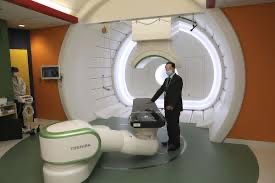
Heavy ion radiotherapy: Light for pancreatic cancer!
– Japan’s 7th Heavy Ion Center Starts Operation –
Heavy ion radiotherapy facility
East Japan Heavy Particle Center
Tohoku’s first heavy ion radiotherapy facility opens.
Yamagata is the seventh heavy ion radiotherapy facility in Japan.
Heavy ion radiotherapy for all cancers will start from the 3rd of this month.
Effect of heavy ion beam:
A type of radiation that “accelerates carbon nuclei to 70% of the speed of light”
When the heavy ion beam is directed at the cancer,
It progresses through the body and rapidly becomes high energy,
It tends to disappear there.
When the peak is aligned with the cancerous part, it destroys only the cancer intensively.
“It is difficult to damage the normal cells in front of and behind it.”
in short,
“Therapeutic effect is higher than X-rays, and side effects are less.”
Cancer treatment with heavy ion radiotherapy:
What is covered by insurance
prostate cancer,
head and neck cancer,
liver cancer,
pancreatic cancer,
cervical cancer,
bone and soft tissue tumor,
And seven for rectal cancer.
Irradiation with heavy ion beam:
It emits a higher dose than X-rays.
Anticancer drugs can be administered to the maximum.
The number of irradiations is 12 times, which is less than half that of X-rays.
Moreover, the frequency of side effects is the same as that of single administration of anticancer drugs.
Clinical trial data:
Two-year survival rate of 48%.
Only 3 of 72 patients had normal tissue damage.
The difference is obvious because the treatment results of chemoradiation are about 10 to 20%.
Cost of heavy ion beam:
For prostate cancer,
The cost of the heavy ion beam is 1.6 million yen,
Stereotactic radiation for 5 times is 630,000 yen (patient burden is 10 to 30% in each case)
In terms of cost, 5 times irradiation is advantageous.
(Nikkan Gendai)-Yahoo! News
https://news.yahoo.co.jp/articles/709d733fac12d472a17a0a252f69e10834def964
Radiothérapie aux ions lourds : la lumière pour le cancer du pancréas !
– Le 7e centre d’ions lourds du Japon entre en service –
Installation de radiothérapie aux ions lourds
Centre de particules lourdes de l’est du Japon
Ouverture de la première installation de radiothérapie aux ions lourds de Tohoku.
Yamagata est la septième installation de radiothérapie aux ions lourds au Japon.
La radiothérapie aux ions lourds pour tous les cancers débutera à partir du 3 de ce mois.
Effet du faisceau d’ions lourds :
Un type de rayonnement qui « accélère les noyaux de carbone à 70 % de la vitesse de la lumière »
Lorsque le faisceau d’ions lourds est dirigé vers le cancer,
Il progresse à travers le corps et devient rapidement de haute énergie,
Il a tendance à y disparaître.
Lorsque le pic est aligné avec la partie cancéreuse, il ne détruit que le cancer de manière intensive.
“Il est difficile d’endommager les cellules normales devant et derrière.”
bref,
“L’effet thérapeutique est supérieur à celui des rayons X et les effets secondaires sont moindres.”
Traitement du cancer par radiothérapie aux ions lourds :
Ce qui est couvert par l’assurance
cancer de la prostate,
cancer de la tête et du cou,
cancer du foie,
cancer du pancréas,
cancer du col de l’utérus,
tumeur des os et des tissus mous,
Et sept pour le cancer du rectum.
Irradiation avec un faisceau d’ions lourds :
Il émet une dose plus élevée que les rayons X.
Les médicaments anticancéreux peuvent être administrés au maximum.
Le nombre d’irradiations est de 12 fois, soit moins de la moitié de celui des rayons X.
De plus, la fréquence des effets secondaires est la même que celle d’une administration unique de médicaments anticancéreux.
Données d’essais cliniques :
Taux de survie à deux ans de 48 %.
Seuls 3 des 72 patients avaient des lésions tissulaires normales.
La différence est évidente car les résultats du traitement de la chimioradiothérapie sont d’environ 10 à 20 %.
Coût du faisceau d’ions lourds :
Pour le cancer de la prostate,
Le coût du faisceau d’ions lourds est de 1,6 million de yens,
Le rayonnement stéréotaxique pour 5 fois est de 630 000 yens (le fardeau du patient est de 10 à 30 % dans chaque cas)
En termes de coût, 5 fois l’irradiation est avantageuse.
(Nikkan Gendai) – Nouvelles de Yahoo!
Schwerionenstrahlentherapie: Licht für Bauchspeicheldrüsenkrebs!
– Japans 7. Schwerionenzentrum nimmt Betrieb auf –
Anlage für Schwerionenbestrahlung
Ostjapanisches Zentrum für schwere Partikel
Eröffnung der ersten Einrichtung für Schwerionenstrahlentherapie in Tohoku.
Yamagata ist die siebte Einrichtung für Schwerionenstrahlentherapie in Japan.
Die Schwerionen-Strahlentherapie für alle Krebsarten beginnt am 3. dieses Monats.
Wirkung des Schwerionenstrahls:
Eine Art von Strahlung, die „Kohlenstoffkerne auf 70 % der Lichtgeschwindigkeit beschleunigt“
Wenn der Schwerionenstrahl auf den Krebs gerichtet wird,
Es schreitet durch den Körper fort und wird schnell hochenergetisch,
Dort verschwindet es gerne.
Wenn die Spitze mit dem kanzerösen Teil ausgerichtet ist, zerstört sie nur den Krebs intensiv.
“Es ist schwierig, die normalen Zellen davor und dahinter zu beschädigen.”
Zusamenfassend,
„Die therapeutische Wirkung ist höher als bei Röntgenstrahlen und die Nebenwirkungen sind geringer.“
Krebsbehandlung mit Schwerionenbestrahlung:
Was ist versichert
Prostatakrebs,
Kopf-Hals-Krebs,
Leberkrebs,
Bauchspeicheldrüsenkrebs,
Gebärmutterhalskrebs,
Knochen- und Weichteiltumor,
Und sieben für Rektumkrebs.
Bestrahlung mit Schwerionenstrahl:
Es gibt eine höhere Dosis ab als Röntgenstrahlen.
Krebsmedikamente können maximal verabreicht werden.
Die Anzahl der Bestrahlungen beträgt das 12-fache, was weniger als der Hälfte der Röntgenstrahlen entspricht.
Darüber hinaus ist die Häufigkeit von Nebenwirkungen die gleiche wie bei der einmaligen Verabreichung von Krebsmedikamenten.
Daten aus klinischen Studien:
Zwei-Jahres-Überlebensrate von 48 %.
Nur 3 von 72 Patienten hatten normale Gewebeschäden.
Der Unterschied ist offensichtlich, da die Behandlungsergebnisse der Radiochemotherapie etwa 10 bis 20 % betragen.
Kosten für Schwerionenstrahl:
Bei Prostatakrebs,
Die Kosten für den Schwerionenstrahl betragen 1,6 Millionen Yen,
Stereotaktische Bestrahlung für 5 Mal beträgt 630.000 Yen (Patientenbelastung beträgt jeweils 10 bis 30 %)
Aus Kostengründen ist eine 5-fache Bestrahlung vorteilhaft.
(Nikkan Gendai) – Yahoo!-Nachrichten